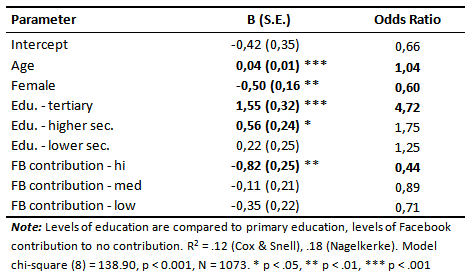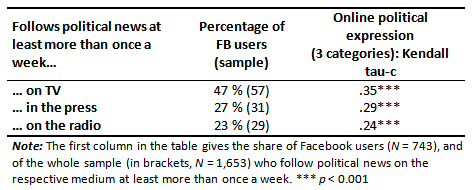Whither slacktivism? Political engagement and social media use in the 2013 Czech Parliamentary elections
Václav Štětka1, Jaromír Mazák22 Institute of Communication Studies, Faculty of Social Sciences & Department of Sociology, Faculty of Arts, Charles University, Prague, Czech Republic
Abstract
Keywords: political participation; online political expression; slacktivism; social network sites; Facebook
Introduction
In recent years, there has been a rapidly increasing body of research exploring the role of online media in facilitating new forms of civic engagement and political participation (see e.g. Bennett & Segerberg, 2013; Carpentier, 2011; Dahlgren, 2013 for an overview). Research interest in this topic has been growing amidst ever more frequently voiced concerns about the crisis of democracy in large parts of the Western world, indicated by decreasing election turnout (Macedo et al., 2005; Putnam, 2000), especially amongst youth (Fieldhouse, Tranmer, & Russell, 2007; Van der Eijk & Van Egmond, 2007); dwindling political party membership (Van Biezen, Mair, & Poguntke, 2012); low trust in politicians and democracy, particularly in the aftermath of the recent economic crisis (Armingeon & Guthmann, 2014), as well as diminishing interest in political affairs among the general population (Banaji & Buckingham, 2013). At the same time, alongside with the reported decline of the long-established, traditional forms of political participation, new opportunities for citizens’ engagement in politics and public affairs have emerged following the growing diffusion of digital information and communication technologies and their increasing presence in the public sphere. While claims about the civic and democratic potential of these technologies have been made from the very onset of the internet in the 1990s, the present-day explosion of social network sites (SNS) and other Web 2.0 applications (see John, 2013) such as Facebook, Twitter or YouTube that enable greater interactivity and user participation in the creation of online political content, has renewed and significantly intensified these (cyber)optimistic perspectives (Castells, 2012; Shirky, 2008).
Simultaneously, however, sceptical perspectives on the capability of the internet and social media to enhance democracy and serve as platforms for political participation have emerged as well (see Fuchs, 2013). Online activism has been criticised for not being followed or complemented by offline forms of participation, and often dismissed as clicktivism or slacktivism (Gladwell, 2011; Halupka, 2014; Karpf, 2010; Morozov, 2009; Shulman, 2009) allegedly fulfilling only the desire for instant self-satisfaction and having little or no impact on actual political processes and citizens’ own real-life actions. The prospect of digital democracy has been dismissed by some authors as a myth, with politics online allegedly displaying more similarities to, rather than differences from, politics as usual (Hindman, 2009).
The question of whether and how social media use augments citizens’ involvement in political affairs and introduces disaffected members of the public into the arena of democratic politics has been perceived as particularly pertinent in the context of election campaigns, which have been increasingly marked by the adoption of social media by politicians and political parties across the Western world. While the internet has served as a medium for political communication since the late 1990s (Blumler & Kavannagh, 1999), the recent arrival of social network sites has clearly broadened the spectrum of online platforms used by parties and candidates to disseminate their messages and communicate with voters, with many of them attempting to emulate the success of the 2008 Barack Obama campaign (Cogburn & Espinoza-Vasquez, 2011) which set the path for Web 2.0 campaigning (Lilleker & Jackson, 2010) in various other countries. Since then, Twitter, Facebook and other social network sites have been adopted in election campaigns by an increasing number of political actors, as recently documented in Sweden (Larsson & Moe, 2012), Finland (Strandberg, 2013), the UK (Lilleker & Jackson, 2010), Italy (Vaccari et al., 2013) or Norway (Enli et al., 2013). While citizen engagement with online campaigning has recently been the subject of a growing number of studies (Gibson & Cantijoch, 2013; Gustafsson, 2012; Holt, Shehata, Strömbäck, & Ljungberg, 2013; Robertson, Vatrapu & Medina, 2010; Strandberg, 2013), evidence on what kind of people get mobilized in the online and SNS environments and how their online participatory activities translate into political engagement offline has so far been fragmented and still rather inconclusive (see e.g. Boulianne, 2009; Gibson & Cantijoch, 2013).
Building on the above outlined theoretical perspectives, our article aims to contribute to this increasingly popular research field by empirically examining the extent and character of political engagement of Czech social media users in the course of the 2013 Czech Parliamentary election campaign, as well as by exploring the question whether SNS users’ online involvement in the campaign is complemented by traditional, mostly offline forms of political participation. This research objective is even more topical because in the Czech Republic, social media have only started to play a more significant role in political communication in the last couple of years, following the campaign of the presidential candidate Karel Schwarzenberg in January 2013, which was particularly successful in mobilizing supporters via Facebook (Štětka, Macková, & Fialová, 2014). The 2013 Parliamentary elections campaign, which took place less than a year after the Presidential Election and which saw the adoption of social network sites by most relevant parties (see Štětka & Vochocová, 2014), therefore provided a unique research opportunity to empirically analyze the Czech electorate’s responsiveness to the use of social network sites as mobilization tools by parties and candidates, as well as to quantitatively assess the adoption and role of social media in the context of a national election campaign by Czech internet users in general. Using data from the 2013 post-election survey on a representative sample of the Czech population (N = 1,653), we attempt to fill a gap in research on the relationship between digital media use and participation in the Czech Republic, which has so far not been subjected to systematic research. We also hope that our study can enrich existing knowledge about social media use and forms of e-participation on an international scale.
Mobilization, Slacktivism and E-expression: Perspectives and Evidence on Online/Offline Engagement
Empirical research investigating the impact of the internet and social media on civic engagement and political participation has mushroomed in recent years (e.g.; Boulianne, 2011; Conroy, Feezell, & Guerrero, 2012; Enjolras, Steen-Johnsen, & Wollebæk, 2013; Gibson & Cantijoch, 2013; Gil de Zúñiga, Molyneux, & Zheng, 2014; Gustafsson, 2012; Holt et al., 2013; Junco, 2013; Rojas & Puig‐i‐Abril, 2009; Strandberg, 2013; Vitak et al., 2011; Zhang, Johnson, Seltzer, & Bichard, 2010). For a large number of studies conducted in this field, the vantage point and a key question to answer is who is engaged through new media, i.e. to what extent the use of internet and Web 2.0 applications in particular mobilizes other segments of the population than those already active or interested in politics (mobilization thesis) or if it merely reinforces existing differences and inequalities within society in terms of political engagement (normalization thesis). However, existing research is far from providing a clear-cut answer to this debate, as studies published so far have arrived at varying conclusions (see Boulianne, 2009; Gustafsson, 2012; Vissers, Hooghe, Stolle, & Maheo, 2011), meaning that proponents of either of the two conflicting theses can find empirical support for their claims in empirical data. Earlier studies conducted before the arrival of social media (Bimber, 2001; Margolis & Resnick, 2000; Norris, 2001) have particularly tended to lean towards the normalization thesis, also embodied in Pippa Norris’s well-known metaphor of a virtuous circle (Norris, 2000), which suggests that exposure to news media (including the internet) is most likely to further activate those citizens who are already politically active and interested in politics. In line with this argument, Weber, Loumakis, and Bergman (2003) have concluded that those who are politically engaged are more likely to use the internet, both generally as well as for political activities. As Banaji and Buckingham sum up, various studies found that “the internet is most heavily used by the ‘usual suspects’ – that is affluent, highly educated young people and by those who are already interested in politics”, while those citizens especially from lower socioeconomic backgrounds “tend to be disengaged – at least from institutional politics – both online and offline” (2013, p. 11; emphasis original).
Apart from this stream of research, contradicting the initial predictions that the internet will make it easier for broader strata of the population to participate in democratic political processes, other scholarship has challenged the alleged societal and political effect of internet use. The term slacktivism, although initially bearing positive connotations vis-à-vis the bottom up activities of young people, has recently become a derogatory word used to play down electronic versions of political participation (Christensen, 2011). It has been popularized particularly by Evgeny Morozov, who has used it to describe “feel-good online activism that has zero political or social impact. [The term] gives to those who participate in ‘slacktivist’ campaigns an illusion of having a meaningful impact on the world without demanding anything more than joining a Facebook group” (Morozov, 2009). While attacking slacktivists for merely engaging in mouse clicking as the least risky and least labour-intensive form of protest – an “ideal type of activism for a lazy generation”, as he puts it – Morozov fears that the increasing dependence on this form of participation might turn ordinary people “away from conventional (and proven) forms of activism (demonstrations, sit-ins, confrontation with police, strategic litigation, etc.)” (ibid.). Although this critique is voiced especially in relation to anti-authoritarian political activism, in the discourse framed by the concepts of slacktivism or clicktivism (see e.g. Halupka, 2014; Karpf, 2010) it has been often extended to include various other sorts of “low effort activities that are considered incapable of furthering political goals as effectively as traditional forms of participation” (Christensen, 2011). Frequently counted among such activities are clicking like on Facebook (or other social buttons), signing online petitions, forwarding letters or videos, or changing a profile picture (Halupka, 2014). The critics of this form of low-key or thin form of engagement tend to emphasise “that individuals perform acts of clicktivism to exercise a sense of moral justification without the need to actually engage” (Halupka, 2014, p. 117).
However, more recent scholarship provides ample empirical research that attempts to rehabilitate clicktivism as a legitimate form of political action (Halupka, 2014) and suggests that there can indeed be a spillover effect from online engagement over to offline participation, even if the effect might not be as strong as initially expected by cyber-optimists. According to Enjolras et al. (2013), this shift towards more positive findings might be explained by the evolution of the online environment itself, and especially by the profound differences in the affordances of social media and Web 2.0 in comparison to the affordances of Web 1.0 and the internet in general. Using individual web survey data from Norway, Enjolras et al. (2013) found that social media mobilize specific socio-demographic segments, and that “participation in Facebook groups has a strong and independent effect on mobilization” (p. 904). Based on a student survey before the 2008 U.S. presidential elections, Vitak et al. (2011) found that political activity on Facebook is a significant predictor of other forms of political participation. Several studies have recently adopted the concept of online political expression to describe online activities such as posting or sharing politically relevant comments or other type of political content, befriending or following politicians and candidates (Gil de Zúñiga, Jung, & Valenzuela, 2012; Gil de Zúñiga, Molyneux, & Zheng, 2014; Rojas & Puig‐i‐Abril, 2009).1 Centering on “the public expression of political orientations’’ (Rojas & Puig-i-Abril, 2009, p. 906), this e-expressive mode of participation (Gibson & Cantijoch, 2013) has been found by the above quoted studies to be significantly related to political participation both online (through donating money, volunteering, writing emails etc.) and – even more importantly – offline. In light of such findings, Gil de Zúñiga et al. have argued that:
Political discussion in person and offline expression, while not being less important, may now be complemented by supplemental paths to political involvement via social media. This supplementary connection to political expression in social media use is promising for the development of a politically active future, especially for younger people (2014, p. 627).
Other empirical studies have also highlighted the fact that when it comes to political mobilization through social media use, younger cohorts are more likely to be affected than older age groups. Using data from a panel survey from the 2010 Swedish national election campaign, Holt et al. (2013) have identified substantial differences in media use for political purposes depending on age, with the youngest group using social media for political purposes significantly more often than any of the older age groups, suggesting, according to the authors, that “social media may function as a leveller of generational differences in political participation” (p. 20). According to Hirzalla, Van Zoonen, and De Ridder (2011), the internet might impact differently on the young and the adult populations – having a mobilization effect on youth and a normalization effect on adults.
Methods
Hypotheses and Operationalization
Drawing on the above presented theoretical framework, we decided to explore, by means of a representative survey of the adult Czech population, the impact of social media use on political engagement in the Czech Republic, focusing particularly on the relationship between the activities conceptualized above as online political expression during the 2013 Parliamentary elections campaign, and the traditional, mostly offline forms of political participation. Therefore, our main research question was formulated as follows:
(RQ1): Is there a link between online political expression during the election campaign and traditional forms of political participation among Czech Facebook users?
Following the above quoted studies (Gil de Zúñiga, Jung, & Valenzuela, 2012; Gil de Zúñiga, Molyneux, & Zheng, 2014; Rojas & Puig‐i‐Abril, 2009; Vitak et al., 2011) we expected that (H1) online political expression during the campaign will be positively correlated with traditional, mostly offline forms of political participation.
Online political expression was measured using a composite index of selected activities during the 2013 Parliamentary elections on Facebook (liking politician’s or party post; commenting on a friend’s contribution about the campaign; sharing contributions by politicians or political parties; becoming a fan of a politician or a political party, commenting on posts by politicians or political parties; adding comments or information concerning elections on one’s own profile; becoming a fan of another political initiative related to elections) and on internet discussion forums (reading online forums about the elections; contributing to these forums). Traditional political participation was measured by five conventionally used indicators (see e.g. Teorell, Torcal, & Montero, 2007; Vráblíková, 2009), namely signing petitions; attending demonstrations or pre-election rallies; taking part in public meetings within a local community; working for a club, local community or an organization and discussing politics offline (on a five-point scale from at least once a day to never). In addition, the sixth indicator specifically measured respondents’ most recent electoral behaviour, namely voting in the 2013 Parliamentary elections.
Furthermore, knowing from previous research on political participation that political interest and political news consumption are counted among important predictors of participatory behaviour, we wanted to know (RQ2) how social media use, both in general and for participation in the campaign in particular, related to political interests; and (RQ3) what the relationship between online expressive participation during the campaign and consumption of political news from traditional mass media (TV, print media and radio) was.
Political interest has been traditionally considered an important resource for political participation (Brady, Verba, & Schlozman, 1995; Norris, 2000) and recent empirical studies have confirmed that this relationship extends into the domain of online participation as well, depending, however, on the type of social media use. While political engagement via social network sites has been linked with higher level of political interest (Boulianne, 2011; Holt et al., 2013; Vitak et al., 2011), an opposite effect has been documented among those who use social network sites more often in general, but not for political purposes (Baumgartner & Morris, 2009; Zhang et al., 2010). Therefore, we expected that (H2a) the overall intensity of SNS use will be negatively associated with political interest, but (H2b) online political expression during the campaign will show a positive relationship to political interest.
The decision to include news consumption in the analysis was based upon the assumption that if online engagement were not accompanied by offline participation (as proposed in the slacktivism thesis), we could expect that those politically active online would not be more likely to consume political news from offline media; on the other hand, if there is a mutually complementing effect of online and offline participation, we should also see a positive link between offline information seeking and online engagement in the election campaign. Given that political news consumption has been proven to foster traditional forms of political participation (McLeod et al., 1999; Norris, 1996), including in the Czech Republic (Tworzecki & Semetko, 2012), and current research suggests the same pattern should be applicable to online participation in the SNS environment as well (Gil de Zúñiga, Jung, & Valenzuela, 2012; Rojas & Puig‐i‐Abril, 2009;), we expected that (H3) online political expression during the campaign will show a positive relationship to political information seeking in mainstream media.
Data and Sample Composition
The data used for this study were obtained by means of a quota sample (N = 1,653) representative of the adult Czech population with regards to region (NUTS 3), size of residence, gender, age and education. The survey was administered using face-to-face interviews between 28 October – 11 November 2013, immediately following the early Parliamentary elections that took place on 25 – 26 October 2013. Table 1 below shows the composition of the sample according to the percentage of internet and social media users:
Online Platforms among Respondents.
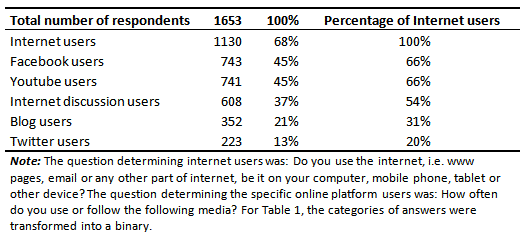
The prevalence of the Czech internet and Facebook users according to basic socio-demographic characteristics (see Table 2) does not contain any particular surprises. Neither internet nor Facebook users differ significantly from the general population in terms of gender composition. However, there still is – also in line with our expectations – a notable divide among different age groups: internet users are on average younger than the general population, with the main gap affecting the oldest group; while in the main sample the age group of 65+ represented 18% of respondents, it was only 6% among those using the internet (which is likely to be influenced by the fact that pensioners are mostly excluded from work-related internet use). The effect of age on Facebook use is even greater: it remains most popular among the youngest population (18-24 years) where it is used by 94 % of the internet users. However, that does not mean Facebook is only used by the youngest cohorts, as suggested by the fact that altogether 36 % of those internet users aged 65+ are also on Facebook. As for education, the share of internet users and Facebook users in each of the four categories of respondents according to their level of education is largely similar, with both of them being overrepresented in the highest education categories (21 % of internet users and 19 % of Facebook users have a university degree, while their share in the sample is 16 %).
Internet Users, and Facebook Users (%).
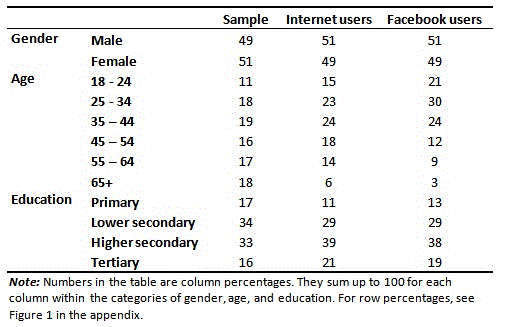
Results
Facebook Use and Political Interest
Exploring the relationship between social media and political engagement, we first take a look at the intensity of active Facebook use (that is, frequency of Facebook users’ own contributions)2 and declared interest in politics.3 As apparent from Graph 1, this relationship is a negative one – the most active Facebook contributors are, at the same time, the least interested in politics; and vice versa, those respondents who do not create content on Facebook at all display relatively the highest level of political interest. Our hypothesis (H2a) is thereby confirmed.
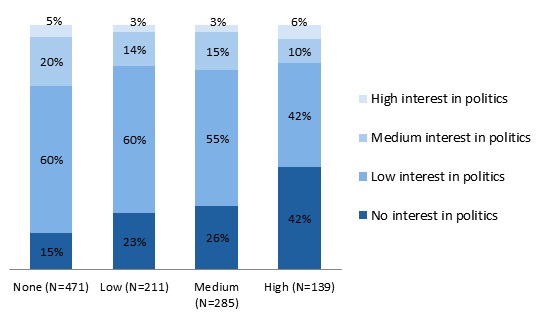
Graph 1: Intensity of general Facebook contribution by Interest in politics; internet users only.
Kendall’s tau-b = - .15. Categories of Facebook contribution intensity are: none; low –
contributes less than once a week; medium – contributes at least once a week but less than daily;
high – contributes at least daily. Interest in politics was declared on the given four-point scale.
However, it could be potentially misleading to interpret this relationship just at face value. We know from the data that actively contributing on Facebook, just like using Facebook in general (see Table 2), is more frequent among young people. Since we also know that Czech – and other – youth display a lower interest in politics (see Linek, 2013), we decided to test whether age is the is indeed the intervening variable behind this correlation. This was to some extent confirmed by a regression analysis (see Table 3), showing that when controlling for age, gender and education, the relationship between the intensity of Facebook contributions and interest in politics only remains statistically significant (and negative) for high level of Facebook contribution.4 In other words, while for majority of active Facebook users the interest in politics is determined by age, those users posting on Facebook at least once per day display greater lack of interest in politics regardless of their age. This somewhat inconclusive finding points to the necessity to examine the relationship between social media use and political participation using a more complex design, and especially with regards to not just political interest but particular political activities of the respondents.
Exploring the Dependency Model
Our analytical strategy was guided by the assumption that it is more meaningful to examine political engagement in the SNS environment, operationalized here as online expressive participation in the election campaign, on the sub-sample of online communication platform users, rather than the general population. Since our indicator of online political expression is primarily based on activities displayed by SNS users during the election campaign period, we have decided to include only Facebook users (N = 743) in the analysis. The alternative solution – to include all respondents regardless of their internet use – might have resulted in mislabelling a significant number of people as politically inactive online, while the primary reason for their lack of online political participation would be in fact the decision not to use Facebook or the internet in the first place.
The dependent variable. As mentioned above, we have used a composite index of activities that respondents engaged in on Facebook as well as on internet discussion forums during the 2013 Parliamentary election campaign as indicator of online political expression. We have included seven such items for Facebook and two for discussion forums (the disparity in the number of items for each of these platforms is due to differences in their affordances, with Facebook enabling a wider range of politically relevant activities). Although questions about Twitter formed part of the survey, we have not included political activities on Twitter in our analysis primarily because of the relatively low penetration of this particular SNS in the Czech Republic (only 13% of respondents use Twitter actively or passively according to the survey). Thereby including Twitter would significantly reduce the sample for testing the relationship between online and offline participation (see above). The frequencies of individual index items are displayed in Graph 2 below.
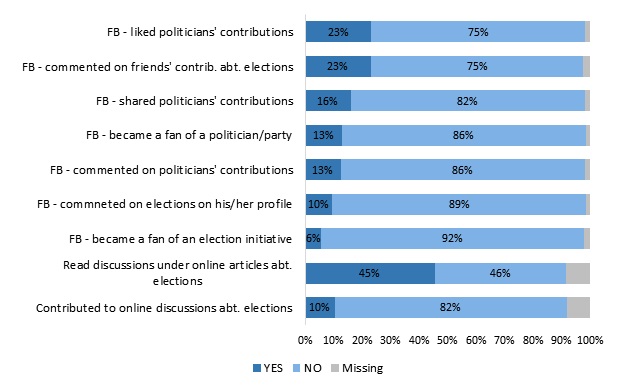
Graph 2: Items for construction of online political expression index
(Facebook users only, N = 743).
As Graph 2 shows, the most predominant activity on Facebook in response to the election campaign was to like a politician’s or a political candidate’s contribution – the sort of activity most often mentioned when illustrating slacktivism (Fuchs, 2013). Altogether 23% of Facebook users claimed to have done that; the same amount of respondents commented on an election-related post on their friends’ profile. However, reading internet discussions under articles about elections has been by far the most frequent activity of all, with almost half of the sub-sample (45%) of Facebook users engaging in it.
We have merged these nine items into a composite index (Cronbach’s Alpha .83). As the distribution of values within the composite index (0-9) proved to be rather skewed, with low frequencies for higher index values, we have transformed it into a categorical variable with three values – no online political expression (none of the nine items answered positively), low online political expression (one to two items present) and high online political expression (three or more items answered positively). The distribution of frequencies of the categorized index is displayed in Graph 3 below.6
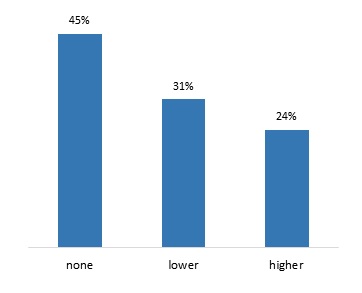
Graph 3: Distribution of the dependent variable:
Categorized online political expression (N = 731)7.
Independent variables. We used six different forms of traditional political participation as independent variables: signing petitions8; attending demonstrations or pre-election rallies; taking part in public gatherings on local community issues; working for a club, local community or organization; discussing politics offline;9 and voting in the 2013 Parliamentary elections.10 Table 4 shows both the frequencies of these activities by Facebook users (compared with the rest of the sample) as well as their relationship to online political expression during the election campaign (measured by the above presented index as the dependent variable).
to Online Political Expression Index.
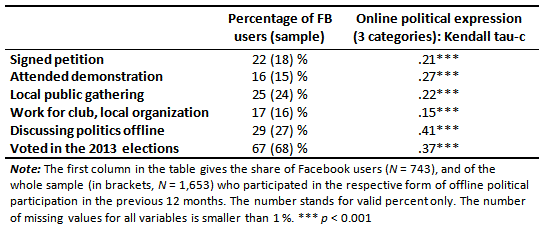
All these individual forms of traditional political participation correlate positively with the index of online political expression, as documented by Kendall tau-c, ranging from .15 to .41 (p < .001);11 thereby our main hypothesis (H1) is confirmed. Interestingly enough, the percentages of respondents who have claimed to take part in these activities are very similar for Facebook users as well as the whole sample; the only slight difference occurs with the variable signing petitions, which is widely considered to be one of the most accessible forms of civic protest, especially given its increasing online distribution (Van Lear & Van Aelst, 2010). This could also explain why it is relatively more prevalent in the sub-sample of Facebook users (compared to the general population) than other traditional participatory activities.
Another group of independent variables to be used for the dependency model were variables measuring political information seeking via different types of “traditional” mass media, i.e. television, radio and the press. In the questionnaire, the answers ranged from never to at least once a day on a five-point scale; however, for the purposes of the model, the variables have been dichotomized, distinguishing only between those using the particular medium for political news consumption at least several times a week, and those using it once a week at most.12 As Table 5 shows, television is the primary source of political information for most people, while the consumption of radio and print news is much less prevalent. For all three types of news media, the respondents from the sub-sample of Facebook users display relatively lower frequencies of political news consumption than the entire sample – a finding similar to that on the lower political interest among the population of Facebook users (see Graph 1), likely to be explained by age at least to some extent. However, it is more important to focus on this particular population in our dependency model, since it can indicate whether the users who are politically active online transfer information about politics from traditional mass media to online platforms.
It is clear from the table that the consumption of political news in traditional media also positively correlates with online political expression during the election campaign (H3 confirmed). People active online seem to be well placed for bringing content from traditional media onto online platforms.
The last independent variable which we include in our analysis is a declared interest in politics. The rationale for this choice is similar to including political news consumption in traditional offline media. We wanted to see whether the relationship between offline and online political participation (the latter in the context of the election campaign) is just an effect of a common cause (in this case a higher level of political interest) or whether it constitutes a genuine relationship. Political interest was measured as an ordinal variable on a four-point scale from none to high but recoded into three categories for the purposes of the model.14 Furthermore, we also include controls (age, gender, education) which have been presented in more detail in previous sections.15
Model. Due to the fact that the dependent variable (online political expression) was coded as an ordered categorical one with three categories, we have used ordinal logistic regression to statistically test our model.16
As displayed in Table 6, traditional forms of political participation – discussing politics offline at least once a week, signing a petition in the previous 12 months, and attending a demonstration or pre-election rally in the previous 12 months – were all significant predictors of online political expression during the election campaign. Voting in the elections is also significantly positively associated with online political participation. This suggests that one of the main assumptions of the hypothesis about clicktivism which argues that pressing the like button is rarely accompanied by showing up for elections, is not confirmed by our data, according to which voting is associated with online political expression even when all the other variables in the model are controlled for.
On the other hand, neither attending public gatherings on local community issues, nor working for a local club or organization in the previous 12 months, turned out to be significant predictors of online political expression during elections.
Online Political Expression as Dependent Variable
(Population: Facebook Users, N = 683).
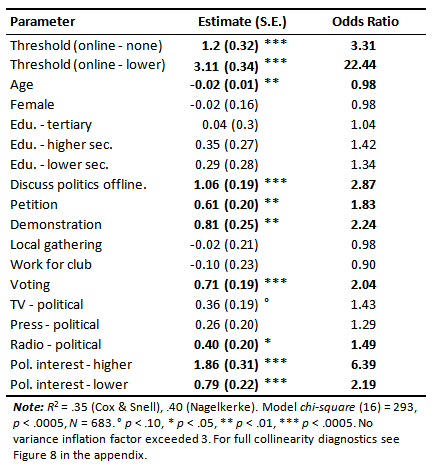
While a declared political interest is clearly indicative of higher online engagement (H2b confirmed), there is little evidence that consumption of political news in traditional offline media helps to predict online political expression during the campaign: only radio is a statistically significant, yet comparatively weak, predictor of online participation. This may come as a surprise, but further analysis shows that excluding declared political interest from the model renders all three offline media significant predictors of online political expression during the campaign (also see Table 5 for bivariate correlations). It seems that the variance in online political expression explained by declared interest in politics and consumption of political news in offline media is largely the same. However, since we are most interested in the actual relationship between different forms of traditional, mainly offline, political participation and online political expression during the campaign, it seems reasonable to keep both the declared interest in politics and the consumption of political news in offline media in the model to control for their effects.
As for the standard control variables of gender, education, and age only the latter has some statistically significant effect: older Facebook users are somewhat less likely to be politically active online.17
Summary and Conclusions
Based on the results of the ordinal logistic regression, we have found support for the claim that the type of politics-related use of social media we have called online political expression (following particularly Gil de Zúñiga, Jung, & Valenzuela, 2012; Gil de Zúñiga, Molyneux, & Zheng, 2014; Rojas & Puig‐i‐Abril, 2009) is positively correlated with some forms of traditional, mainly offline political participation, thereby confirming our first hypothesis (H1). It is therefore not the case that those people who become fans of politicians and parties on Facebook, or who read, share or create political content on social network sites in the course of the election campaign would not have time or motivation to be politically active in the offline world, as some of the sceptical prognoses regarding the role of SNSs in civic mobilization would assume. On the contrary, these Czech internet users are often more politically active than those who do not engage in online politics. Our data make it plausible to argue that those who have been politically active online during the election campaign are also more likely to vote in elections; they engage in offline conversations about politics more often; they are more frequently present at demonstrations or pre-election rallies; and to some extent they are more easily convinced to sign petitions than those people who tend to avoid political engagement using the internet and social network sites. Apart from that, and confirming our hypothesis (H3), they also consume political news from traditional media more often, thereby transferring information between the online and offline information environments, even though this relationship is statistically weakened in the regression model when controlling for political interest. This obviously does not necessarily mean that there are no information bubbles or echo chambers (see Black, 2011) which attract politically or ideologically like-minded Internet users; on the other hand it does not seem that borders between such spaces would merely follow the divisions between the online and offline worlds. Summarizing the results, we also need to stress that our analysis found a positive relationship between online political expression and respondents’ political interest (H2b confirmed), which remains strong and significant even when controlling for the selected types of offline political participation.
While we believe that our study offers some solid empirical findings that question the slacktivism thesis, the data presented above cannot be interpreted as conclusively proving the mobilization thesis either. This is mainly due to the limitations stemming from our largely exploratory research design and the fact that we relied on a cross-sectional survey, which did not enable the testing of the possible causal effect of online participation on offline engagement, as did, for example, Holt et al. (2013) in their panel study. In this respect, even though our findings are very much congruent with the above quoted study – demonstrating a positive relationship between the use of social media for political purposes, political interest and offline participation – we are unable to draw conclusions about the direction of the influence within this relationship. We are also aware that the ability to formulate broader conclusions from this study regarding the predictors of online political expression might be limited by the fact that the key indicators of online participation were related to respondents’ behaviour during the very specific period of the election campaign. While such periods usually increase citizens’ interest in politics and the levels of their engagement, their effect might be ephemeral, and the patterns of Internet and SNS use for political purposes do not have to be maintained during the time following the election campaign. Further research should therefore target not only these politically exposed but essentially rather rare occasions when citizens are being collectively mobilized by parties and candidates for electoral support, but also the more routine periods when political and civic engagement may take other forms and do that with different intensity, both online and offline.
Acknowledgement
This research was supported by the Czech Science Foundation (GACR), Standard Grant Nr 14-05575S – “The Role of Social Media in the Transformation of Political Communication and Citizen Participation in the Czech Republic”, and by the project Prvouk P17, Faculty of Social Sciences, Charles University in Prague.
Notes
1. Explaining the conceptual difference between political expression and participation, de Zúñiga and his colleagues claim that “political expression is conceptually distinct from political participation in the way that political talk is distinct from political action” (Gil de Zúñiga, Molyneux, & Zheng, 2014, p. 614).
2. Unlike Facebook use in general, this variable measures the intensity of Facebook use for active self-expression, rather than merely engaging with Facebook content. It has to be added, though, that the two variables (Facebook use and active Facebook use) display strong correlation (Kendall’s tau-b = 0.74).
3. See Table A2 and A3 in the Appendix for more information on the two variables.
4. For the purposes of the binary logistic regression, declared political interest was recoded as 1 for the answers very interested, quite interested, and little interested (77 % of the Internet users in the sample) and as 0 for not at all interested (23 % of the Internet users in the sample). The rationale for this cut point is obvious from the Graph 1, where the difference clearly manifests mainly between the category of no political interest and the remaining three categories cumulatively.
5. See Table A4 in the Appendix for collinearity diagnostics.
6. See Graph A1 in the Appendix for the distribution of the index prior to its recoding.
7. N is smaller than the total number of Facebook users in the sample (743) due to missing answers. We did not include respondents with more than two missing values for the index in the analysis.
8. The questionnaire did not specify online or offline petition, thereby respondents could interpret it either way.
9. Discussing politics offline was transformed into a dichotomous variable distinguishing between those who debate politics in the offline environment at least once a week and those who discuss it less often than that. See Table A6 in the Appendix for the distribution of discussing politics prior to dichotomization.
10. The real turnout in the 2013 elections was just below 60 %. However, a discrepancy between the actual election turnout and a result from surveys is a very much common phenomenon, usually explained by the fact that some people do not want to admit they did not vote (Linek, 2013).
11. We considered transforming the four less correlating variables (petition, demonstration or pre-election rally, local public gathering; and work for club or local organization) into one variable. However, Cronbach’s alpha for these four items was only 0.59 and hence insufficient to justify the construction of an index. Therefore we opted for entering variables to the regression model individually.
12. See Table A5 in the Appendix for the original distribution prior to dichotomization.
13. The number stands for valid percent only. The number of missing values for all variables is smaller than 1 %.
14. See Table A3 in the Appendix for the recoding scheme.
15. Age is the only continuous variable used in the model. It does not have a normal distribution since it is truncated at the age of 18 on the left side due to research design. We therefore checked if the linearity assumption is not violated by conducting an analysis with interaction of age and its logarithm added to the basic analytical design (Hosmer & Lemeshow, 1989/2000). The parameter was not significant which indicates that the assumption of linearity is not violated and we could include age in the model.
16. Ordinal logistic regression makes an additional assumption about the data compared to multinomial logistic regression, which we have considered as an alternative statistical method for our study. Namely, it assumes that the regression lines estimated by the model can be considered parallel without significant decrease in the model’s quality. We have tested this assumption with parallel lines test with resulting p-value of 0.06. Such a value is very close to the conventional border value of 0.05. Even though we decided to publish the more compact ordinal model in the body of the article, we enclose the multinomial model in Table A8 in the Appendix in order to enable a comparison of results. We think that the results of the two models are almost identical although differences tend to diminish or even disappear when comparing the category of higher and lower online political participation in the multinomial model.
17. To estimate the size of the individual effects just discussed, we need to look more closely at the odds ratio column in Table 6. It explains that, for example, the likelihood of higher online political expression is 6.39 times (2.19 times) greater for people with higher (lower) political interest than people with no political interest. Due to the nature of the ordinal logistic regression model (as provided in SPSS under the name PLUM), the same can be said for the joint likelihood of higher and lower online political expression. Similarly, the chance of higher online political expression is 2.87 times greater for those who discuss politics offline at least once a week compared to those who do not. Of course, the likelihood of higher or lower online political expression is again estimated as 2.87 times greater for those who discuss politics offline than for those who do not do it at least once a week. The effect size of other independent variables can be interpreted from the table in the same fashion.
References
Banaji, S., & Buckingham, D. (2013) The civic web. Young people, the Internet, and civic participation. Cambridge, MA: The MIT Press.
Baumgartner, J. C., & Morris, J. S. (2009). MyFaceTube politics: Social networking web sites and political engagement of young adults. Social Science Computer Review. Advanced online publication. http://dx.doi.org/10.1177/0894439309334325
Bennett, W. L., & Segerberg, A. (2013). The logic of connective action: Digital media and the personalization of contentious politics. Cambridge: Cambridge University Press.
Bimber, B. (2001). Information and political engagement in America: The search for effects of information technology at the individual level. Political Research Quarterly, 54, 53-67. http://dx.doi.org/10.1177/106591290105400103
Black, L. W. (2011). The promise and problems of online deliberation. Charles F. Kettering Foundation, Inc. Retrieved from: http://kettering.org/publications/the-promise-and-problems-of-online-deliberation/
Blumler, J. G., & Kavanagh, D. (1999). The third age of political communication: Influences and features. Political Communication, 16, 209-230. http://dx.doi.org/10.1080/105846099198596
Boulianne, S. (2009). Does Internet use affect engagement? A meta-analysis of research. Political Communication, 26, 193-211. http://dx.doi.org/10.1080/10584600902854363
Boulianne, S. (2011). Stimulating or reinforcing political interest: Using panel data to examine reciprocal effects between news media and political interest. Political Communication, 28, 147–162. http://dx.doi.org/10.1080/10584609.2010.540305
Brady, H. E., Verba, S., & Schlozman, K. L. (1995). Beyond SES: A resource model of political participation. American Political Science Review, 89, 271-294. http://dx.doi.org/10.2307/2082425
Carpentier, N. (2011). Media and participation: A site of ideological-democratic struggle. Bristol; Chicago: Intellect.
Castells, M. (2012). Networks of outrage and hope: Social movements in the Internet age. Chichester, UK: Wiley.
Christensen, H. S. (2011). Political activities on the Internet: ‘Slacktivism’ or political participation by other means? First Monday, 16(2). http://dx.doi.org/10.5210/fm.v16i2.3336
Cogburn, D. L., & Espinoza-Vasquez, F. K. (2011). From networked nominee to networked nation: Examining the impact of web 2.0 and social media on political participation and civic engagement in the 2008 Obama campaign. Journal of Political Marketing, 10, 189–213. http://dx.doi.org/10.1080/15377857.2011.540224
Conroy, M., Feezell, J. T., & Guerrero, M. (2012). Facebook and political engagement: A study of online political group membership and offline political engagement. Computers in Human Behavior, 28, 1535–1546. http://dx.doi.org/10.1016/j.chb.2012.03.012
Dahlgren, P. (2013). The political web: Media, participation and alternative democracy. Basingstoke, New York: Palgrave Macmillan.
Enjolras, B., Steen-Johnsen, K., & Wollebæk, D. (2013). Social media and mobilization to offline demonstrations: Transcending participatory divides? New Media & Society, 15, 890–908. http://dx.doi.org/10.1177/1461444812462844
Enli, G., Larsson, A., Kalsnes, B., Skogerbø, E., Moe, H., Bruns, A., … Artieri, G. B. (2013). Social media and elections: The use of Twitter in the 2013 campaigns in Italy, Australia, Germany, and Norway. Selected Papers of Internet Research, 3. Retrieved from: http://spir.aoir.org/index.php/spir/article/view/869
Fieldhouse, E., Trammer, M., & Russell, A. (2007). Something about young people or something about elections? Electoral participation of young people in Europe: Evidence from a multilevel analysis of the European Social Survey. European Journal of Political Research, 46, 797-822. http://dx.doi.org/10.1111/j.1475-6765.2007.00713.x
Fuchs, C. (2013). Social media: A critical introduction. London: Sage.
Gibson, R., & Cantijoch, M. (2013). Conceptualizing and measuring participation in the age of the internet: Is online political engagement really different to offline?. The Journal of Politics, 75, 701-716. http://dx.doi.org/10.1017/S0022381613000431
Gil de Zúñiga, H., Jung, N., & Valenzuela, S. (2012). Social media use for news and individuals' social capital, civic engagement and political participation. Journal of Computer‐Mediated Communication, 17, 319-336. http://dx.doi.org/10.1111/j.1083-6101.2012.01574.x
Gil de Zúñiga, H., Molyneux, L., & Zheng, P. (2014). Social media, political expression, and political participation: Panel analysis of lagged and concurrent relationships. Journal of Communication, 64, 612-634. http://dx.doi.org/10.1111/jcom.12103
Gladwell, M. (2011). From innovation to revolution-do social media made protests possible: An absence of evidence. Foreign Affairs, 90, 153.
Gustafsson, N. (2012). The subtle nature of facebook politics: Swedish social network site users and political participation. New Media & Society, 14, 1111–1127. http://dx.doi.org/10.1177/1461444812439551
Halupka, M. (2014). Clicktivism: A systematic heuristic. Policy & Internet, 6, 115-132. http://dx.doi.org/10.1002/1944-2866.POI355
Hindman, M. (2009). The myth of digital democracy. New York: Lexington Books.
Hirzalla, F., Van Zoonen, L., & De Ridder, J. (2011). Internet use and political participation: Reflections on the mobilization/normalization controversy. Information Society, 27(1), 1–15. http://dx.doi.org/10.1080/01972243.2011.534360
Holt, K., Shehata, A., Strömbäck, J., & Ljungberg, E. (2013). Age and the effects of news media attention and social media use on political interest and participation: Do social media function as leveller? European Journal of Communication, 28, 19–34. http://dx.doi.org/10.1177/0267323112465369
Hosmer, D. W., & Lemeshow, S. (2000). Applied logistic regression. New York: Wiley.
John, N. A. (2013). Sharing and web 2.0: The emergence of a keyword. New Media & Society, 15, 167–182. http://dx.doi.org/10.1177/1461444812450684
Junco, R. (2013). Inequalities in facebook use. Computers in Human Behavior, 29, 2328–2336. http://dx.doi.org/10.1016/j.chb.2013.05.005
Karpf, D. (2010). Online political mobilization from the advocacy group's perspective: Looking beyond clicktivism. Policy & Internet, 2(4), 7-41. http://dx.doi.org/10.2202/1944-2866.1098
Larsson, A. O., & Moe, H. (2012). Studying political microblogging: Twitter users in the 2010 Swedish election campaign. New Media & Society, 14, 729–47. http://dx.doi.org/10.1177/1461444811422894
Lilleker, D. G., & Jackson, N. A. (2010). Towards a more participatory style of election campaigning: The impact of web 2.0 on the UK 2010 general election. Policy & Internet, 2(3), 67–96. http://dx.doi.org/10.2202/1944-2866.1064
Linek, L. (2013). Kam se ztratili voliči? Vysvětlení vývoje volební účasti v České republice v letech 1990-2010. Brno: Centrum pro studium demokracie a kultury.
Macedo, S., Alex-Assensoh, Y., Berry, J. M., Brintnall, M., Campbell, D. E., Fraga, L. R., ... & Galston, W. W. (2005). Democracy at risk. Washington, DC : The Brookings Institution.
Margolis, M., & Resnick, D. (2000). Politics as usual: The cyberspace 'revolution'. Thousand Oaks: Sage Publications.
McLeod, J. M., Scheufele, D. A., Moy, P., Horowitz, E. M., Holbert, R. L., Zhang,W., ... & Zubric, J. (1999). Understanding deliberation the effects of discussion networks on participation in a public forum. Communication Research, 26, 743–774. http://dx.doi.org/10.1177/009365099026006005
Morozov, E. (2009, May 19). “The brave new world of slacktivism,” Foreign Policy. Retrieved from: http://neteffect.foreignpolicy.com/posts/2009/05/19/the_brave_new_world_of_slacktivism
Norris, P. (1996). Does television erode social capital? A reply to Putnam. Political Science and Politics, 29, 474–480. http://dx.doi.org/10.1017/S104909650004511X
Norris, P. (2000). A virtuous circle: Political communications in postindustrial societies. Cambridge: Cambridge University Press.
Norris, P. (2001). Digital divide: Civic engagement, information poverty, and the Internet worldwide. Cambridge: Cambridge University Press.
Putnam, R. D. (2000). Bowling alone: The collapse and revival of American community. New York: Simon.
Robertson, S. P., Vatrapu, R. K., & Medina, R. (2010). Off the wall political discourse: Facebook use in the 2008 US presidential election. Information Polity, 15, 11-31.
Rojas, H., & Puig‐i‐Abril, E. (2009). Mobilizers mobilized: Information, expression, mobilization and participation in the digital age. Journal of Computer‐Mediated Communication, 14, 902-927. http://dx.doi.org/10.1111/j.1083-6101.2009.01475.x
Shirky, C. (2008). Here comes everybody: The power of organizing without organizations. New York: Penguin Books.
Shulman, S. W. (2009). The case against mass e-mails: Perverse incentives and low quality public participation in US federal rulemaking. Policy & Internet, 1(1), 23–53. http://dx.doi.org/10.2202/1944-2866.1010
Štětka, V., Macková, A., & Fialová, M. (2014). A winding road from “likes” to votes: The role of social media in the 2013 Czech presidential elections. In B. Patrut (Ed.), Social media in politics: Case studies (2008-2013). Berlin: Springer-Verlag.
Štětka, V., & Vochocová, L. (2014, June). A dialogue of the deaf, or communities of debate? The use of Facebook for campaign communication and citizen participation in the 2013 Czech parliamentary elections. Paper presented at the CEECOM 2014 conference, Wroclaw, Poland.
Strandberg, K. (2013). A social media revolution or just a case of history repeating itself? The use of social media in the 2011 Finnish parliamentary elections. New Media & Society, 15, 1329–1347. http://dx.doi.org/10.1177/1461444812470612
Teorell, J., Torcal, M., & Montero, J. R. (2007). Political participation: Mapping the terrain. Citizenship and Involvement in European Democracies: A Comparative Perspective, 17, 334-357.
Tworzecki, H., & Semetko, H. A. (2012). Media use and political engagement in three new democracies: Malaise versus mobilization in the Czech Republic, Hungary, and Poland. The International Journal of Press/Politics. http://dx.doi.org/10.1177/1940161212452450
Vaccari, C., Valeriani, A., Barberá, P., Bonneau, R., Jost, J. T., Nagler, J., & Tucker, J. (2013). Social media and political communication. RIVISTA ITALIANA DI SCIENZA POLITICA, 43(3). Retrieved from: https://files.nyu.edu/jat7/public/2013_IPSR.pdf
Van Biezen, I., Mair, P., & Poguntke, T. (2012). Going, going,... gone? The decline of party membership in contemporary Europe. European Journal of Political Research, 51, 24-56. http://dx.doi.org/10.1111/j.1475-6765.2011.01995.x
Van der Eijk, C., & Van Egmond, M. (2007). Political effects of low turnout in national and European elections. Electoral Studies, 26, 561-573. http://dx.doi.org/10.1016/j.electstud.2006.10.003
Van Lear, J., Van Aelst, P. (2010) Internet and social movement action repertoires. Information, Communication & Society, 13, 1146-1171. http://dx.doi.org/10.1080/13691181003628307
Vissers, S., Hooghe, M., Stolle, D., & Maheo, V.-A. (2011). The impact of mobilization media on off-line and online participation: Are mobilization effects medium-specific? Social Science Computer Review, 30, 152–169. http://dx.doi.org/10.1177/0894439310396485
Vitak, J., Zube, P., Smock, A., Carr, C. T., Ellison, N., & Lampe, C. (2011). It’s complicated: Facebook users’ political participation in the 2008 election. Cyberpsychology, Behavior, and Social Networking, 14, 107–114. http://dx.doi.org/10.1089/cyber.2009.0226
Vráblíková, K. (2009). Politická participace a její determinanty v postkomunistických zemích. Sociologický časopis/Czech Sociological Review, 5, 867-897.
Weber, L. M., Loumakis, A., & Bergman, J. (2003). Who participates and why? An analysis of citizens on the Internet and the mass public. Social Science Computer Review, 21, 26-42. http://dx.doi.org/10.1177/0894439302238969
Zhang, W., Johnson, T. J., Seltzer, T., & Bichard, S. L. (2010). The revolution will be networked: the influence of social networking sites on political attitudes and behavior. Social Science Computer Review, 28, 75–92. http://dx.doi.org/10.1177/0894439309335162
Appendix
Socio-Demographic Variables.
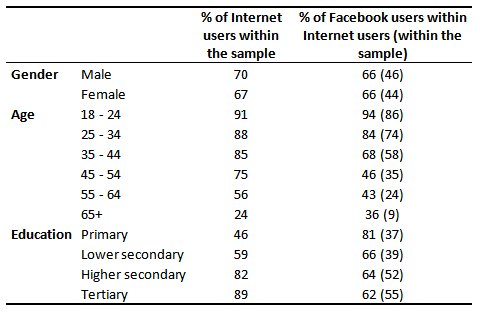


Information for Binary Logistic Regression for Interest in Politics.
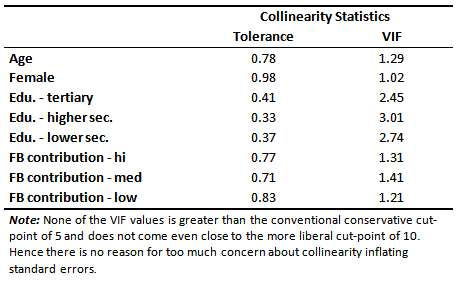
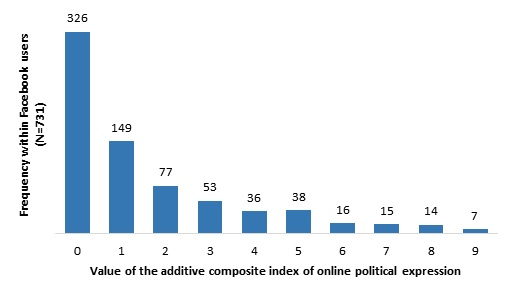
Graph A1: Distribution of online political expression index
(Facebook and Internet discussion forums) prior to recoding.
on Radio and in Press (as Column Percentage,
Valid Percent).

Offline prior to its Dichotomization (Valid Percent).
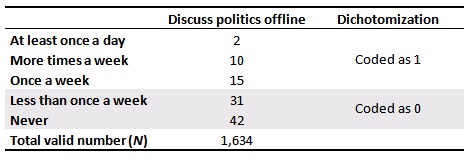
Information for Ordinal Logistic Regression (Table 6).
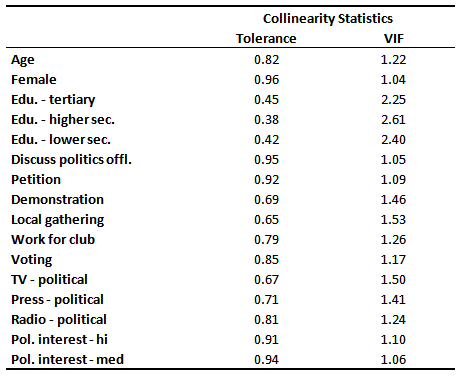
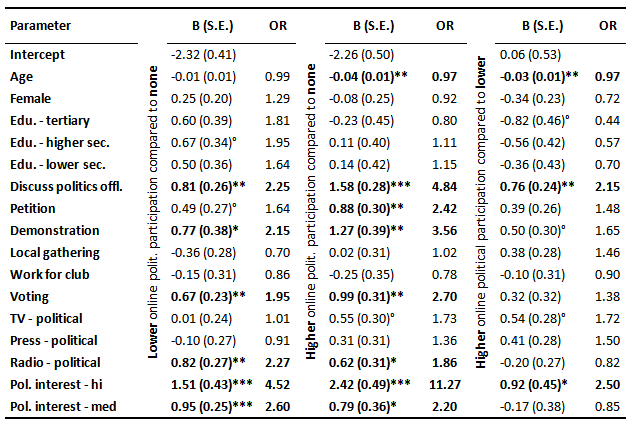
Correspondence to:
Václav Štětka
Institute of Communication Studies and Journalism
Faculty of Social Sciences
Charles University in Prague
Smetanovo nábřeží 1
110 01 Praha 1
tel. +420 222 112 166
Email: vaclav.stetka(at)fsv.cuni.cz
